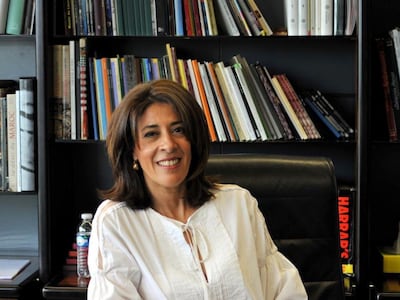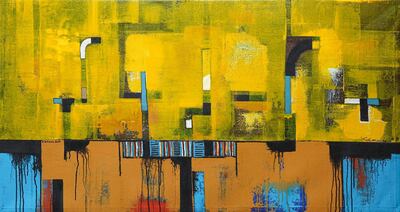Egyptian sculptor Adam Henein died last year, leaving behind some of the country's best-known monuments, the restoration of the Great Sphinx and the feted Aswan International Sculpture Symposium, devoted to nurturing young Egyptian artists.
But when curator Mona Khazindar met him in Cairo in 2016, Henein wanted to show her something different: his charcoal drawings, warm and intimate in scale. He asked her if she would do a book on them, and Khazindar agreed. But life and other projects got in the way, and when Henein died, the book was still in doubt.
Khazindar, by that point, had left the Institut du Monde Arabe in Paris, and had started working at the Saudi Ministry of Culture. Now, for an initiative called The Art Library: Discovering Arab Artists, by the kingdom’s Misk Art Institute, Khazindar is editing a new series of books that aim to rectify the paucity of scholarship on Arab artists.
The first two volumes are on the seminal Saudi painter Abdulrahman Al Soliman and Henein, whose charcoal drawings will be shown for the first time. Volume one is titled Abdulrahman Alsoliman: Signs and Symbols and volume two is Adam Henein: Charcoal Drawings.
Returning to Henein was, says Khazindar, “a promise I had to fulfil”. The Art Library series will release three pairs of books a year, published in English and Arabic: one on a Saudi artist and two on Arab artists. Modern art by heavyweights such as Al Soliman and Henein will be a focus, as will photography, contemporary art and calligraphy.
"When I was at the Institut du Monde Arabe, we frequently saw that artists lacked documentation or archives. I became more and more convinced that it was necessary to document the artists and their work before it was too late," says Khazindar, who became the first female director general at the cultural institute in Paris in 2011.
Through images, meticulous research and commissioned essays, the open-ended series aims to answer that call. The Art Library series will also be strategic in its approach. Each book will have two main essays, one written by an international critic and the other by a critic from the artist's country or the Arab region. Misk hopes that the international critic will help to raise awareness about the artists beyond the region. And as for the Arab critic, the institute hopes these books will have a knock-on effect.
“We don’t have lots of art critics in the Arab world because there is little tradition of public art discourse,” says Khazindar. “So the idea is to give opportunities, and little by little make a change.”
Iranian-British art specialist Roxane Zand and Iraqi writer Farouk Yousif wrote on Al Soliman, a pioneer who joined the famous Dar Al Funoon Al Sa'udiyyah (The Saudi Art House), founded in 1979. There, he painted Cubist-inspired works, replete with voluminous forms, and later shifted into more abstract, more loosely painted and architectural canvases.
Appropriately for the start of this series, both Henein and Al Soliman contributed to the development of the art scene in their respective countries. Al Soliman wrote one of the few books on Saudi art history, The March of Saudi Art, in 2000, and Henein donated his private art collection to Egypt to become a public museum.
Henein also has a long-standing relationship with Saudi Arabia. Jeddah's Al Mansouria Foundation, run by Princess Jawaher bint Majed Al Saud, supported Henein, and in 2005 published a monograph on his work, also edited by Khazindar. For her, The Art Library initiative is necessary not only for understanding Arab culture, but also the region's past.
“These artists documented history – the social and political upheavals of the time,” she says. “I am thinking of Egypt and the nationalisation of the Suez Canal, which different artists documented in their paintings, or political events, such as the 1967 [Arab-Israeli] War or the First Intifada. And they studied abroad, they came back, and they created their own identity. All this evolution and movement is necessary to document and how to understand where we are.”
The lack of documentation around Arab artists is compounded by the language divide, where the information that does exist is mostly in Arabic. The Arab Library is one of a number of new initiatives seeking to overcome this separation between Arab culture and that of the West.
In 2010, NYU Abu Dhabi launched the Library of Arabic Literature, which commissions translations of important Arabic works into English, again in a standardised library format.
The 2018 book Modern Art in the Arab World: Primary Documents similarly included English translations of important Arabic texts on Modern Arab art history. Misk contributed funding to the title, which was made in association with the Museum of Modern Art in New York.
As the art landscape in Saudi Arabia grows, Misk's role is emerging as an educational one, as well as one that supports artist initiatives.
For the launch of the The Art Library, Misk is hosting an exhibition of the work of Al Soliman and Henein, as well as the outcomes of the inaugural Masaha residency, a four-month mentorship programme for artists and curators in Riyadh.
Works by Abdulrahman Al Soliman and Adam Henein are on view at the Prince Faisal bin Fahd Arts Hall in Riyadh until August. The residency showcase, Blurring Lines: Art & the Creative Industries, is also at the same venue until Saturday, June 26








